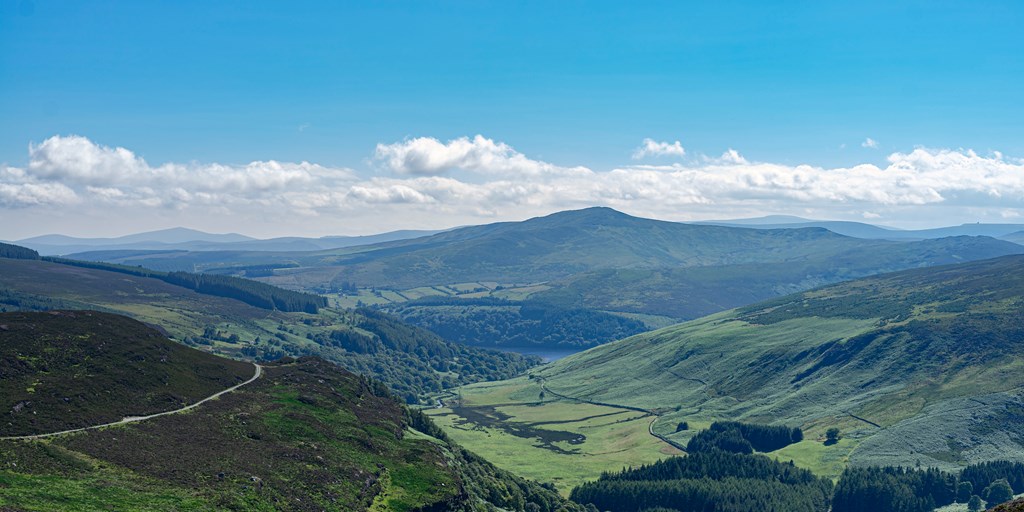The Mountain of the Women

That day in Ireland, from the peak of Slievenamon mountain, if you were looking north east, you’d have seen a red dot of a car moving along the narrow road. It was the O’Driscals out again on another of their Sunday drives.
They were from a small townsland, up north. A good, well let’s say, a good two hours if you were taking your time, less now with the new motorway. It isn’t a place you’d be familiar with if you you didn’t live nearby. The only landmark was a creamery at the crossroads. That’s long closed now. Mary O’Brien, God rest her soul, used to run that creamery for years, and for a while her son Billy, was the milk man, may he rest in peace. So if you ever visit, well now you know a few people who lived there.
And wasn’t it Doreen, the third daughter of the O’Brien’s of the creamery, who married O’Driscal. And wasn’t it him this very minute that was driving that red Toyota Corolla towards the mountain. A fine family of six, out for a Sunday drive.
“Slievenamon is the highest mountain in Tipperary,” said father. “From the top you can see three towns and four rivers.” He talked half over his shoulder keeping his eyes mostly on the road. Their mother, Doreen, from the old creamery, was in the passenger seat, tense, looking hard at the road, making up for the father’s lack of attention, keeping an eye out, for tractors and cyclists and other Sunday-drivers.
In the back seat of the Corolla, the four children were squashed together like ham and cheese sandwiches. Three boys and a girl. The youngest two in the middle, since the bigger were quicker, making sure they got the window seats.
“Why is it called Slievenamon?” said the youngest.
Father smiled. He stopped at a T-junction and looked left and right. Mother looked left and right too. And they drove on.
Well, father told the story. And the children were delighted.
…
But dear reader, don’t you know the story of Slievenamon?
Here’s how I heard it, and it might be different than how Mr. O’Driscal told it.
In olden time in Ireland, Fionn mac Cumhaill, (pronounced ‘cool’) the greatest warrior hunter in Ireland, was down for a few weeks hunting wild boar in the Golden Vale — the name of the region around the mountain. Now as well a being a great warrior hunter, Fionn was a fierce man for the ladies.
After the few weeks, there was many a woman in that county that had, ah, experienced Fionn’s sweet words and many who felt he’d be their husband. Each thought that she was only one hearing his sweet words.
Well, when it was discovered that Fionn was talking sweetly to so many, there was consternation. Every woman and man in the Vale, took the side of the slighted women and the entire county was under threat of falling into complete mayhem. Something had to be done.
So Fionn went and thought about it and thought about it some more and after three days, with the Vale on the verge of disaster — because not a single woman would do a days work till the matter was resolved — Fionn decided he would take for his bride the best of the lot, and how would he decide? They’d have a race.
The date was set and the course would be from Kilcash to the summit of the mountain, about 3 miles, or 5 kilometres if you prefer. The first woman to get to the summit would win Fionn’s hand. The race was held, the woman ran and the first to get to the top, was Gráinne, the daughter of the Cormac Mac Airt, the high king of Ireland. From that day the mountain was called Slieve, which means mountain and na mbán, which means women. Slievenamon, mountain of the women. And that’s how that mountain got its name.
Sure by the time father had finished telling the story the red Corolla arrived at the outskirts of Kilcash, and the rain had come and there was no point trying to climb the mountain. The mother was relieved to be out of the car and instead of climbing, they had fish and chips in a café on main street, except the youngest, he wanted a battered sausage. After lunch they visited the castle, it’s a ruin, but for four children in raincoats, racing around, t’was wonderful.
On the road back, both the youngest two slept and the eldest two looked out through the windows at the rain and the green fields.
“She didn’t marry him” said Mother.
“Who didn’t marry who?” asked Father.
“Gráinne didn’t marry Fionn. She married Diarmuid, one of Fionn’s warriors.”
“Did she?” said the father.
“She did.” They pulled in to one side to let the big truck behind them pass, and continued on.
“Gráinne and Diarmuid eloped on the night before her wedding. Fionn was too old, he was older than her father. Diarmuid and Gráinne spent many a year on the run, with Fionn and his warriors after them. Then they made peace and settled down and they had four children.”
Father smiled. Didn’t he have four children with this wonderful woman, and didn’t he love her enough to run away with her when the O’Briens of the creamery hadn’t approved.
They drove back through the rain, and they talked about where they’d go next Sunday, maybe as far as Birdhill Rock. But that’s another story.